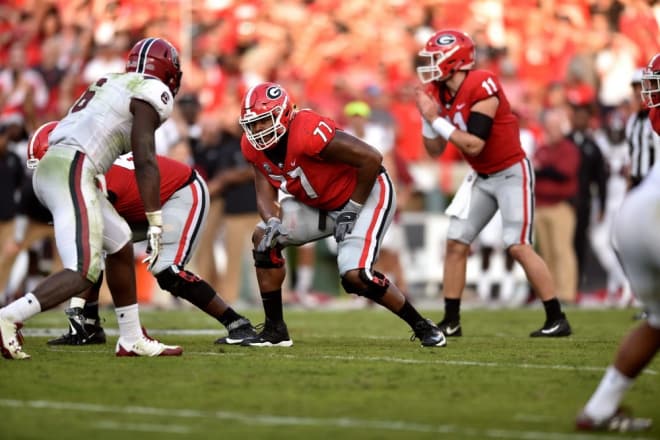Wynn Says “Hogs” Expect Even More

On Wednesday night following Georgia’s practice in preparation to face Auburn, a simple question was asked of senior left tackle Isaiah Wynn, but one which answer would seem applicable to the Bulldogs’ success this season, especially when compared to a year ago: What is the main reason why Georgia’s offensive line is better than last year?
“[In year one] it’s hard to buy into a coaching staff that just came in. You’re on a whole different scheme; it’s hard to buy in,” said Wynn, whose 35 career starts entering Saturday are the second most among offensive players, trailing tight end Jeb Blazevich’s 36. “[This year] we bought in. We’re more comfortable with the coaching staff. We [now] have expectations.”
Since the unit was considered perhaps the team’s biggest weakness entering the season, it could be determined the offensive line has exceeded any expectations nine games into the 2017 campaign.
In mid-October, Wynn was the lone Bulldog recognized as a Midseason All-American by The All-American, the college football sector of The Athletic website. Around the same time, Georgia’s offensive line was one of 21 recognized on the Mid-Season Honor Roll for the Joe Moore Award, which identified notable performances by offensive line units in games played through early October.
Since then, in the development of the unit, the school notes the offensive line paved the way for a season-high 423 rushing yards on 54 carries (7.8 avg.) against Vanderbilt, the sixth most for a single game in Georgia history, and the most since during the 1987 season. Against Missouri, the Bulldogs piled up 370 rushing yards and finished with the second-most total yards (696) in school history. This was followed by a 292-yard, four-touchdown effort on the ground against Florida after the Gators had allowed only four rushing touchdowns in their first six games.
Before “buying in” or any other reason citing how an inadequate Georgia offensive line a year ago improved to arguably one of the best in the nation, perhaps it is important to first indicate how a team’s offensive line play can be measured beyond honors bestowed to individuals and the unit, and statistical highlights from only a few games. Accordingly, from a number’s standpoint, an appropriate performance index can be calculated from data to suggest an offensive line’s overall efficiency for any given season: the Hog Index.
Originally an NFL comparative measurement for offensive line performance, the Hog Index was tweaked a tad by me for the college game, whereby the unit’s efficiency is determined by what could be recognized as the three core statistics in measuring a team’s offensive line: yards per rush, negative passing plays, and conversion rate.
The yards-per-rush average is adjusted for sacks allowed; negative pass plays is the percentage of pass attempts (plus sacks) which resulted in an interception or sack; and conversion rate is the combination of third and fourth downs converted into first downs. The three statistics are ranked in comparison to other teams being measured, resulting in an average ranking.
In Wynn and company’s case through nine games, they have been integral in the team averaging 6.07 yards per rush (sacks omitted) which currently ranks second in the SEC, a negative-pass-play percentage of 8.77, the fifth lowest in the conference, and a 51.54 conversion rate which ranks first. Georgia’s average ranking of the three, a 2.67, suggests the Dawgs’ “Hogs” have been one of the best units in the SEC this season:
| Team | Yards Per Rush ranking | Neg. Pass Play ranking | Conversion Rate ranking | AVG. of 3 Rankings | |
|---|---|---|---|---|---|
|
1) Alabama |
1st |
4th |
2nd |
2.33 |
|
|
2) Georgia |
2nd |
5th |
1st |
2.67 |
|
|
3) Miss. State |
3rd |
3rd |
3rd |
3.00 |
|
|
4) Missouri |
7th |
2nd |
6th |
5.00 |
|
|
5) Auburn |
4th |
10th |
4th |
6.00 |
|
|
6) Vanderbilt |
14th |
1st |
8th |
7.67 |
|
|
T-7) Arkansas |
8th |
13th |
5th |
8.67 |
|
|
T-7) LSU |
5th |
11th |
10th |
8.67 |
|
|
T-9) Kentucky |
11th |
9th |
7th |
9.00 |
|
|
T-9) Texas A&M |
10th |
8th |
9th |
9.00 |
|
|
11) Ole Miss |
9th |
7th |
12th |
9.33 |
|
|
12) S. Carolina |
12th |
6th |
11th |
9.67 |
|
|
13) Florida |
6th |
14th |
13th |
11.00 |
|
|
14) Tennessee |
13th |
12th |
14th |
13.00 |
Considering a Hog Index in 2016 which ranked seventh in the SEC, and a sub-standard 27th of the 65 Power Five teams, coupled with the fact they returned only two starters from the offensive line last season, including Wynn, both of whom are slotted at different positions than they primarily played in 2016, I think it’s safe to say the Bulldogs have exceeded expectations upfront offensively. Yet, as evident in the table above, although only the slightest from a comparative perspective, the offensive line could perform even better—a notion echoed by at least one of Georgia’s “Hogs.”
“It’s definitely a great start [for the offensive line], a great place to be at this point of the season,” Wynn said, but added, “Of course, we’re always striving to get better.”